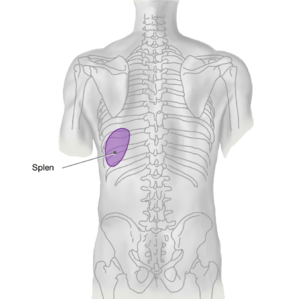Milz/en: Unterschied zwischen den Versionen
Becher (Diskussion | Beiträge) (Die Seite wurde neu angelegt: „The spleen lies intraperitoneally in the left upper abdomen. Between the strong connective tissue threads that run into the interior of the organ lies an arran…“) |
Becher (Diskussion | Beiträge) (Die Seite wurde neu angelegt: „<h2>Projection of the spleen onto the trunk</h2> 300px|right|Spleen: Location of the spleen in the trunk The spleen lies in the left upp…“) |
||
| Zeile 13: | Zeile 13: | ||
The white pulp, on the other hand, contains lymphocytes and is therefore part of the lymphatic system. They have the task of immunological defence reaction. | The white pulp, on the other hand, contains lymphocytes and is therefore part of the lymphatic system. They have the task of immunological defence reaction. | ||
| − | <h2> | + | <h2>Projection of the spleen onto the trunk</h2> |
| − | [[File:Lage_milz.png|300px|right| | + | [[File:Lage_milz.png|300px|right|Spleen: Location of the spleen in the trunk]] |
| − | + | The spleen lies in the left upper abdomen and is not palpable in a healthy, normal condition. Since it has not grown together with the diaphragm, like the liver, its position is strongly dependent on breathing. It lies under the diaphragm and is therefore directly affected by the movements of the diaphragm. | |
<div class="clear"></div> | <div class="clear"></div> | ||
Version vom 3. Januar 2020, 14:16 Uhr
Inhaltsverzeichnis
Structure of the spleen (Splen)
| View on Facies costalis | View on Facies visceralis |
<segmenter>https://dornheim.cloud/index.php/apps/segmenter/embedding/view?identifier=hHyjjNIiVFKb</segmenter>
The spleen lies intraperitoneally in the left upper abdomen. Between the strong connective tissue threads that run into the interior of the organ lies an arrangement of reticular connective tissue formed by fibroblasts (splenic pulp). The splenic pulp is divided into the red and white pulp. The shape of the spleen is very variable. However, it is surrounded by a relatively solid, connective tissue capsule, which is why its outer shape is quite constant and reminiscent of a coffee bean. It is about 7 cm wide, 4 cm high and 11 cm long.
The red pulp is strongly supplied with blood in the living organ (high number of erythrocytes), hence the name and colour. It makes up the largest part of the parenchyma.
The white pulp, on the other hand, contains lymphocytes and is therefore part of the lymphatic system. They have the task of immunological defence reaction.
Projection of the spleen onto the trunk
The spleen lies in the left upper abdomen and is not palpable in a healthy, normal condition. Since it has not grown together with the diaphragm, like the liver, its position is strongly dependent on breathing. It lies under the diaphragm and is therefore directly affected by the movements of the diaphragm.
Lage der Milz im Horizontalschnitt
Die Milz ist über Bauchfellduplikatoren verbunden mit der hinteren Leibeswand (Lig. splenorenale) und mit dem Magen (Lig. gastrosplenicum). Sie liegt in einer Nische. Die Bursa omentalis reicht mit der Ausbuchtung (Recessus splenicus) bis zur Milz.
Milz in situ
Im "WebViewer" ist die enge Nachbarschaft der Milz zur Cauda pancreatis und zur Flexura coli sinistra zu erkennen. Bei einer krankhaften Vergrößerung, kann die Milz auf Magen und Colon drücken und starke Schmerzen verursachen. Die Milz entwickelt sich in dem Omentum majus, welches aus der Entwicklungsgeschichte hervorgehend ein dorsales Mesenterium ist. Durch die Magendrehung wird die anfänglich hinter dem Darmrohr liegende Milz in den linken Oberbauch verschoben.
weiterführende Links

